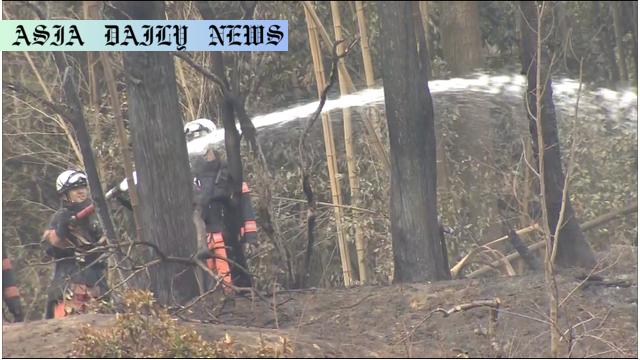Wildfires have burned vast hectares in Japan’s western regions, damaging homes, warehouses, and threatening communities.
- Wildfires in western Japan have burned over 442 hectares in Imabari City.
- 21 structures were damaged, including 11 homes and 10 warehouses.
- Okayama City’s fire has spread across 565 hectares damaging 6 structures.
- Firefighters and Self-Defense Force helicopters are actively combating the blazes.
- Rain forecasts bring hope for relief and containment efforts.

Wildfires in Western Japan: A Growing Crisis
The wildfires raging in western Japan since Sunday have created significant challenges for residents and authorities alike. Imabari City, located in the country’s western region, has been at the center of this natural disaster. As of Thursday afternoon, the fires have consumed more than 442 hectares of land, causing widespread devastation. Mayor Tokunaga Shigeki confirmed during a disaster response meeting that while the intensity of the flames has weakened, white smoke continues to rise from multiple locations, causing concern for residents in affected areas. A total of 21 structures—11 homes and 10 warehouses—have suffered damage, underscoring the destructive force of these wildfires.
The Firefighting Efforts in Imabari City
Firefighters in Imabari City struggled to control the flames early on, but a concerted effort from local and national resources seems to have turned the tide. Despite their efforts, the flames continued to spread across large tracts of forested areas before being brought under partial control. Adding to the firefighters’ challenges, shifting winds and dry weather exacerbated the situation. Fortunately, weather forecasts predict substantial rainfall across the Touyo region, including Imabari, through Friday. This brings a glimmer of hope for further containment as the rains can help suppress remaining hot spots and prevent additional spread.
A Larger Threat in Okayama City
Meanwhile, Okayama City faces an even larger crisis as wildfires there have burned roughly 565 hectares across city limits and the neighboring region of Tamano. Six structures, including homes and warehouses, have already been affected. Firefighting efforts in Okayama have ramped up significantly, with Thursday marking the launch of the largest operation to date. Over 400 personnel, supported by 11 Self-Defense Force helicopters, are tirelessly deploying resources to prevent the fire from approaching residential and business areas. As in Imabari, rain in the southern Okayama Prefecture is predicted to assist containment efforts. Firefighters have resolved to continue their operations through the night, utilizing every resource to protect lives and property.
The Emotional and Economic Cost of the Wildfires
For residents in both regions, the wildfires’ emotional burden cannot be understated. Families who lost homes face uncertainty and financial strain, while local businesses grapple with damaged warehouses and potential supply disruptions. The damage to infrastructure and natural resources also threatens long-term economic challenges. Communities must balance immediate relief efforts with long-term plans for recovery, including forest restoration and rebuilding homes. Meanwhile, environmental experts highlight the importance of addressing climate change and land management practices to reduce the risk of similar disasters in the future.
Final Thoughts and Hope for Recovery
Despite the chaos, there is hope on the horizon. Residents remain resilient, coming together to support each other during these trying times. Firefighters continue to demonstrate remarkable courage, prioritizing public safety while taking personal risks. With rainfall predicted in the coming days, the collaborative efforts of firefighters and natural weather patterns may finally bring these devastating wildfires under control. However, the road to full recovery will require time, resources, and unwavering solidarity among affected communities.



Commentary
The Significance of Efficient Disaster Response
The recent wildfires in western Japan highlight the critical necessity for efficient disaster response strategies. Local authorities, firefighters, and Japan’s Self-Defense Forces have undertaken extraordinary measures to contain the blazes, but terrain, weather conditions, and the sheer size of the fires present ongoing challenges. The use of helicopters and a significant number of ground personnel reflects a commendable level of preparedness and determination, showcasing the importance of collaboration during crises.
The Emotional Toll on Residents
Beyond the structural and environmental damage, it’s important to consider the emotional toll on affected residents. Losing a home is more than just losing a structure—it’s the loss of memories, stability, and a sense of security. Watching flames engulf neighboring areas while helplessly waiting for updates is an experience of anxiety and stress that will leave scars for years. Affected families will need not just financial assistance but ongoing emotional and psychological support to cope with this traumatic event.
Hope for the Future
Despite the devastation, rays of hope emerge as communities show great resilience. Reports of neighbors assisting each other, firefighters receiving gratitude, and expected rainfall relieving affected areas reflect the strength and unity that natural disasters tend to bring out in people. However, this event serves as a poignant reminder of the importance of preventive measures. Japan, being a country prone to natural disasters, must prioritize stronger environmental policies and land management strategies to minimize future risks. Addressing the root causes, including climate change and urban planning in fire-prone areas, is essential for safeguarding lives, land, and livelihoods from future crises.